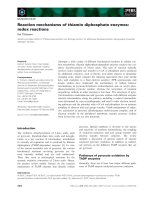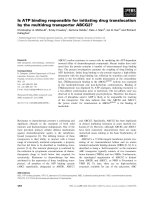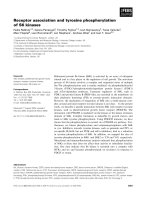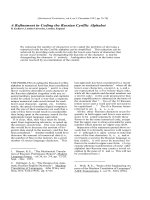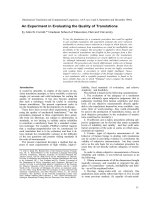Báo cáo khoa hoc:" Sire design power calculation for QTL mapping experiments" pdf
Bạn đang xem bản rút gọn của tài liệu. Xem và tải ngay bản đầy đủ của tài liệu tại đây (389.5 KB, 7 trang )
Note
Sire
design
power
calculation
for
QTL
mapping
experiments
Antonello
Carta
a
Jean-Michel
Elsen
a
Istituto
Zootecnico
e
Caseario
per
1a
Sardegna,
Bonassai,
07040
Olmedo
(SS),
Italy
b
Station
d’amélioration
génétique
des
animaux,
Inra,
BP
27,
31326
Castanet-Tolosan
cedex,
France
(Received
25
May
1998;
accepted
2
February
1999)
Abstract -
Estimates
of
sire
design
power
for
QTL
mapping
experiments
obtained
using
three
different
methods
of
algebraic
approximation
were
analysed
by
comparing
them
with
the
results
of
data
simulations.
Even
when
the
binomial
probability
that
any
number
of
sires
out
of
the
total
number
of
sires
are
jointly
heterozygous
at
the
marker
and
the
QT
loci
was
taken
into
consideration,
the
algebraic
approximations
overestimated
powers.
However,
they
could
be
used
to
rank
designs
differing
in
the
number
of
sires
if
the
total
size
of
the
experiment
is
given.
The
results
were
discussed,
focusing
on
the
assumptions
made
about
the
number
of
informative
offspring,
the
balance
between
the
two
offspring
sub-groups
which
receive
the
same
marker
allele
from
the
sire
and
the
distribution
of
the
statistic.
Given
that
a
full
algebraic
approach
would
be
computationally
costly,
data
simulation
can
be
considered
a
useful
tool
in
estimating
the
power
of
QTL
detection
sire
designs.
©
Inra/Elsevier,
Paris
QTL/
power/
simulation/
protocol
design
Résumé -
Calcul
de
la
puissance
de
détection
de
QTL
dans
un
modèle
« père ».
Trois
méthodes
analytiques
pour
l’estimation
de
la
puissance
du
protocole
fille
pour
la
détection
des
(!TLs
à
l’aide
d’un
marqueur
flanquant
ont
été
étudiées
en
comparaison
avec
des
résultats
obtenus
par
simulation.
Ces
estimations
sont
surestimées,
même
quand
est
prise
en
compte
la
distribution
de
probabilité
du
nombre
de
pères
double
hétérozygotes
au
marqueur
et
au
QTL.
Cependant,
elles
peuvent
être
utilisées
pour
classer
des
protocoles
de
façon
relative,
à
taille
de
population
totale
fixée.
Les
résultats
sont
discutés
en
référence
aux
hypothèses
sur
le
nombre
de
descendants
informatifs,
la
balance
entre
les
descendants
selon
l’allèle
marqueur
reçu
de
leur
père,
et
la
nature
des
distributions.
Compte
tenu
du
coût
numérique
élevé
d’un
calcul
analytique
complet,
les
simulations
demeurent
un
outil
efficace
pour
l’estimation
de
la
puissance
de
ces
protocoles
de
détection
de
QTL. @
Inra/Elsevier,
Paris
QTL/
puissance/
simulation/
planification
expérimentale
*
Correspondence
and
reprints
E-mail:
1.
INTRODUCTION
The
use
of
genetic
markers
to
locate
genes
whose
polymorphism
partly
explains
the
genetic
variability
of
quantitative
traits
was
proposed
by
Sax
[3]
and
further
detailed
by
Neimann-Sorensen
and
Robertson
[2]
and
others.
The
principle
is
to
identify,
in
the
offspring
of
an
individual,
those
which
received
one
or
other
of
the
two
chromosomal
fragments
surrounding
the
marker
in
question.
If
a
quantitative
locus
is
located
on
this
fragment,
and
if
the
parent
is
heterozygous
at
both
the
marker
and
QTL
(quantitative
trait
locus),
then
a
systematic
difference
is
observed
between
the
two
sub-groups
of
progeny.
With
the
development
of
molecular
markers
based
on
DNA
variations,
the
application
of
these
ideas
has
become
feasible
on
a
large
scale
particularly
in
livestock
populations,
where
large
families
are
routinely
recorded.
The
design
of
such
experiments
has
been
studied
in
detail
by
a
number
of
authors,
in
particular
Soller
and
Genizi
[4]
and
Weller
et
al.
[6].
In
order
to
optimize
these
designs,
it
is
necessary
to
estimate
their
power.
Focusing
on
simple
population
structures,
Soller
and
Genizi
[4],
as
well
as
Weller
et
al.
[6],
approached
this
power
estimation
considering
fully
balanced
populations,
and
using
approximate
distributions
of
the
test
statistic.
In these
early
papers,
markers
were
studied
one
by
one,
and
the
test
statistics
applied
were
simple
ANOVA
methods,
modelling
trait
means
as
linear
combinations
of
sire
and
marker
within
sire
effects.
In
their
approximation,
these
authors
worked
with
the
asymptotic
X2
or
normal
approximation
of
the
F
statistic,
and
considered
simply
the
mean
contrast
averaging
different
possibilities
for
the
sire
and
offspring
genotypes
at
the
QT
and
marker
loci.
The
power
of
such
designs,
as
well
as
more
complex
experiments
involving
two
or
three
generations
and
mixing
half-
and
full-sib
families,
was
further
studied
by
van
der
Beek
et
al.
!5).
In
their
paper,
these
authors
considered
the
mixture
of
sub-populations,
as
characterized
by
the
number
of
heterozygous
sires
at
the
QTL,
rather
than
the
mean.
Alternatively,
the
estimate
of
the
design
power
may
be
obtained
by
sim-
ulating
heterogeneous
populations
and
applying
studied
test
statistics
to
the
generated
sets
of
data,
without
any
approximation,
but
at
the
expense
of
more
computing
time.
This
approach
was
followed
by
Le
Roy
and
Elsen
[1]
in
a
study
addressing
the
relative
value
of
ANOVA
and
maximum-likelihood
methods
for
QTL
detection.
The
aim
of
this
study
is
to
evaluate
the
validity
of
approximate
sire
design
power
estimates,
by
comparing
three
algebraic
methods
with
simulating
data.
2.
HYPOTHESES
AND
COMPARED
METHODS
2.1.
Hypotheses
Powers
were
calculated
for
a
single
marker
analysis.
Multiallelic
marker
loci
(with
na
=
4
alleles)
were
studied.
Alleles
Mi
were
assumed
to
be
distributed
with
frequencies
in
a
geometric
series
(f,
=
f,
f2
=
o f,
f3
=
a2
f, ,
with
f
=
1/(1+cr+a2 )).
In
this
situation,
the
parameter
a
was
obtained,
given
the
mean
heterozygosity
of
the
marker
(E( f hm)),
solving
the
equation
E( f hm)
_
1
_
I:i(
o:i-l
)2 /(I
:io:
i
-l )
2.
This
marker
was
supposed
to
be
totally
linked
to
the
QTL.
The
design
was
organized
with
np
half-sib
families
comprising
no
progenies
per
sire.
mp
was
the
expected
number
of
sires
for
which
a
marker
contrast
can
be
computed,
i.e.
the
expected
number
of
heterozygous
sires
at
the
marker
locus,
and
lp,
the
expected
number
of
heterozygous
sires
at
both
marker
and
QT
loci.
mo
was
the
expected
effective
family
size,
i.e.
the
mean
number
of
offspring
per
sire
for
which
the
marker
allele
received
from
the
sire
is
identified.
This
effective
family
size
is
linked
to
the
allele
frequencies
by
the
relation:
mo
=
£i
j 2 f
z
f, (1 -
0.5(f
i
+
/,))/E,
j
2/,/
j.
The
first
type
error
cx
(accepting
a
linked
QTL
when
it
does
not
exist)
was
fixed
at
1
%.
2.2.
Compared
methods
The
following
three
approximations
were
studied.
1)
The
approximation
used
by
Weller
et
al.
!6!:
in
this
approximation,
only
mean
sire
and
daughter
numbers
were
considered.
The
power
was
given
by
Pl
=
P !F(NC(lp), mp, mp(mo - 2)) >
f],
where
F (NC(lp), mp, mp(mo - 2))
is
a
non-central F
variable
with
a
non-centrality
parameter
NC(lp)
and
mp
and
mp(mo -
2)
degrees
of
freedom.
The
threshold
f
corresponds
to
the
(1 -
0
:)
percentile
of
the
central
F
distribution.
The
NC(lp)
is
computed
as:
NC(lp)
=
lpE
2
(MC)/SE
2
(MC),
where
E2
(MC)
is
the
square
of
the
expectation
of
a
marker
contrast
and
SE
2
(MC)
is
the
square
of
the
standard
error
of
the
marker
contrast.
If
a
sire
is
heterozygous
at
the
QTL,
then
E2
(MC)
=
GE
2
(1 -
r)
2,
where
GE
z
is
the
square
of
the
gene
effect
and
r
the
recombination
rate
between
the
marker
locus
and
the
QTL.
For
a
half-sib
family
SE
is
calculated
as
(4 -
h2
)/mo
where h
2
is
the
polygenic
heritability
of
the
trait
(within
QTL
genotype).
2)
The
approximation
followed
by
van
der
Beek
et
al.
!5!:
in
this
approxima-
tion,
the
variability
in
number
of
heterozygous
sires
at
the
QTL
is
considered.
The
power
was
given
by:
where
xp
is
the
number
of
heterozygous
sires
at
the
QTL
and
Pr(xp/mp)
is
the
binomial
probability
that
xp
out
of
mp
(the
expected
number
of
heterozygous
sires
at
the
marker
locus)
are
heterozygous
also
at
the
QTL.
3)
An
approximation
where
variation
at
both
the
sire
marker
and
the
QT
loci
are
considered.
The
power
was
given
by:
where
yp
is
the
number
of heterozygous
sires
at
the
marker
locus
and
Pr(yp/np)
is
the
binomial
probability
that
yp
out
of
np
sires
are
heterozygous
at
the
marker
locus.
4)
In
order
to
test
the
reliability
of
the
three
algebraic
methods
above,
the
design
power
was
also
estimated
by
simulating
data
and
applying
the
standard
F
test.
For
each
power
calculation
10 000
replicates
were
used
under
the
null
and
the
alternative
hypotheses.
The
variance
ratio
for
the
classic
hierarchical
ANOVA
was
calculated
as:
where
Zi
M1h;
(resp.
Zi
M2k
)
are
the
quantitative
performances
of
the
jth
daughter
of
an
heterozygous
M1M2
sire
i,
which
received
marker
allele
All
(resp.
M2),
and
T!Mi
(resp.
nil’
ln)
is
their
number.
The
power
was
estimated
by
the
ratio
between
the
number
of
replicates
under
the
alternative
hypothesis
whose
statistic
exceeds
a
certain
threshold
and
the
total
number
of
replicates.
The
threshold
was
the
(1 -
a)
percentile
of
the
10 000
replicates
under
the
null
hypothesis.
Thus,
no
assumptions
about
the
distribution
of
the
statistic
were
made.
3. RESULTS
Table
I
reports
the
power
estimates
of
sire
designs
with
a
half-sib
family
structure
for
a
gene
effect
(GE)
of
0.5
or
1
phenotypic
standard
deviation
(<
7
p),
for
various
numbers
of
sires,
for
two
total
experiment
sizes
(tno
equal
to
500
or
1000
daughters),
for
a
constant
polygenic
heritability
hz
of
0.25
and
assuming
a
recombination
rate
(r)
of
0.
Expected
heterozygosities
at
both
loci,
marker
and
QT,
are
assumed
to
be
0.5.
Four
alleles
are
segregating
at
the
marker
locus
with
frequencies
0.664, 0.229,
0.079
and
0.028.
Note
that
the
total
heritability
(including
the
variation
at
the
QTL)
equals
0.375
if
GE
=
0.5,
0.75
if
GE
=
1.0.
It
is
shown
that
when
the
gene
effect
is
one
half
ap
and
the
total
experiment
size
is
500
daughters,
the
three
algebraic
methods
give
similar
results
and,
considering
that
the
power
is
low
in
this
situation,
these
approximations
only
slightly
overestimated
the
power
as
compared
to
the
simulated
data.
The
results
for
the
same
GE
but
with
a
total
experiment
size
of
1000
daughters,
confirm
that
no
significant
differences
exist
between
algebraic
methods
except
when
the
number
of
sires
is
low
in
which
case
Pl
greatly
overestimated
the
power.
The
overestimation
of
algebraic
methods
with
respect
to
simulations
is
more
important
here
than
it
is
with
a
total
experiment
size
of
500
daughters.
As
regards
the
GE
of
1.0
Qr
&dquo;
when
the
total
experiment
size
is
500
daughters
algebraic
results
continued
to
overestimate
power
except
for
P3,
when
the
number
of
sires
is
equal
to
2,
in
which
case
PI
gives
particularly
high
power
compared
to
the
other
algebraic
and
simulation
methods. For
a
total
experiment
size
of
1 000
daughters,
PI
greatly
overestimated
power
for
any
considered
number
of
sires,
while
P2
and
P3
give
results
more
similar
to
simulated
data.
estimates
for
a
constant
total
experiment
size
and
number
of
sires
(1000
and
10,
respectively),
for
two
GE
values
(0.5
and
1
Op)
with
various
expected
frequencies
of
heterozygosity
at
the
marker
locus
(E( f hm))
and
at
the
QTL
(E( f hq))
are
shown
in
table
11.
When
GE
is
equal
to
0.5
and
E( f hm)
is
low
(0.25-0.5)
the
differences
between
algebraic
methods
are
negligible
and
there
is
evidence
that
the
overestimation
of
algebraic
methods
tends
to
become
more
important
as
E( f hq)
increases.
Algebraic
results
are
more
realistic
when
E( f hm)
is
0.75
which
corresponds
to
equal
frequencies
(0.25)
for
the
four
alleles
at
the
marker
locus.
The
same
trends
can
be
pointed
out
for
a
GE
of
1
up.
Nevertheless,
in
this
case
P1
tends
to
estimate
higher
powers
than
other
algebraic
methods
and
the
differences
between
simulations
and
algebraic
methods
become
very
large.
4.
DISCUSSION/CONCLUSION
These
results
showed
that
important
differences
exist
between
power
calcu-
lated
with
algebraic
approximations
and
simulating
data.
Even
if
the
binomial
probability
that
any
number
of
sires
out
of
the
total
number
of
sires
are
jointly
heterozygous
at
both
the
marker
and
the
QT
loci
is
taken
into
account,
as
in
the
P3
method,
algebraic
approximation
cannot
always
be
used
to
estimate
the
power
of
different
sire
designs
for
QTL
detection
when
the
total
experiment
size
is
given.
However,
even
though
they
overestimate
power,
P2
and
P3
could
be
used
to
rank
designs
differing
in
the
number
of
sires
when
the
total
size
of
the
experiment
is
given.
On
the
contrary,
it
seems
to
be
inadequate
not
to
in-
clude
the
binomial
probability
and
to
use
the
expected
number
of
heterozygous
parents
also
in
order
to
optimize
the
choice
of
the
number
of
sires
mainly
when
the
total
experiment
size
is
given,
the
gene
effect
is
large
and
the
expected
frequencies
of
heterozygotes
at
the
marker
and
at
the
QT
loci
are
close
to
0.5.
The
same
conclusions
can
be
drawn
from
an
analysis
carried
out
considering
a
diallelic
marker
locus
(unpublished
data).
Probably,
part
of
the
difference
between
the
algebraic
and
simulation
results
can
be
attributed
to
assumptions
made
about
the
number
of
informative
offspring
per
sire,
the
balance
between
the
two
offspring
sub-groups
which
receive
the
same
marker
allele
from
the
sire,
and
the
distribution of
the
statistic.
As
regards
the
distribution
of
the
statistic,
it
should
be
noted
that
the
use
of
x2
distribution
instead
of
F
did
not
significantly
change
the
algebraic
estimates
obtained
in
this
work
(unpublished
data).
All
in
all,
it
would
be
programming
and
computing
costly
to
consider
all
eventualities
concerning
the
offspring
sub-group
sizes
using
a
full
algebraic
approach.
Thus,
simulating
the
data
can
still
be
considered
in
these
situations
as
the
most
useful
tool
for
estimating
the
power
of
QTL
detection
sire
designs.
REFERENCES
[1]
Le
Roy
P.,
Elsen
J.M.,
Numerical
comparison
between
powers
of
maximum-
likelihood
and
analysis
of
variance
methods
for
QTL
detection
in
progeny
test
designs:
the
case
of monogenic
inheritance,
Theor.
Appl.
Genet.
90
(1995)
65-72.
[2]
Neimann-S
o
rensen
A.,
Robertson
A.,
The
association
between
blood
groups
and
several
production
characteristics
in
three
Danish
cattle
breeds,
Acta
Agric.
Scand.
11
(1961)
163 196.
[3]
Sax
K.,
The
association
of
size
differences
with
seed
coat
pattern
and
pigmen-
tation
in
Phaesolu.s
vulgarus,
Genetics
8
(1923)
552-560.
[4]
Soller
M.,
Genizi
A.,
The
efficiency
of
experimental
designs
for
the
detection
of
linkage
between
a
marker
locus
and
a
locus
affecting
a
quantitative
trait
in
segregating
populations,
Biometrics
34
(1978)
47-55.
[5]
van der Beek
S.,
van Arendonk
J.A.M.,
Groen
A.F.,
Power
of
two- and
three-
generation
QTL
mapping
experiments
in
an
outbred
population
containing
full-sib
or
half-sib
families,
Theor.
Appl.
Genet.
91
(1995)
1115-1124.
[6]
Weller
J.L.,
Kashi
Y.,
Soller
M.,
Power
of
daughter
and
granddaughter
de-
signs
for
determining
linkage
between
marker
loci
and
quantitative
trait
loci
in
dairy
cattle,
J.
Dairy
Sci.
73
(1990)
2525-2537.


